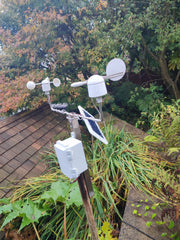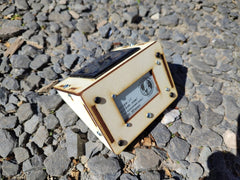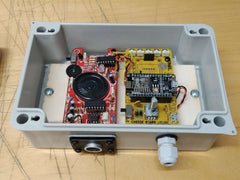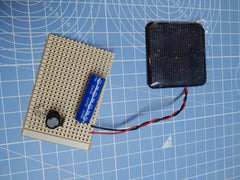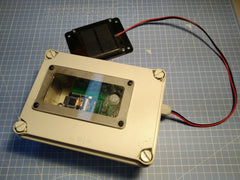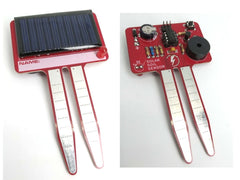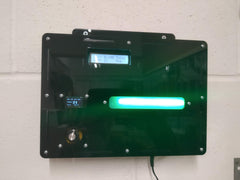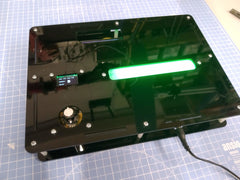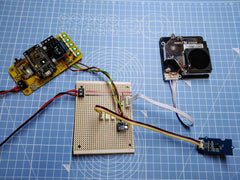Updated Wind Sensor
Posted by Matthew Little on
This is a post to highlight all the changes and testing that has gone into the new design Wind Sensor Interface. I developed this sensor board to monitor different wind speed sensors (anemometers) and wind direction sensors (vanes). The main problem was that the wind speed changes rapidly and so any data-logging system needs to be powered up and recoding... Read more
- 0 comment
- Tags: citizen science, education, educational, environment, wind
Solar E-Paper Display
Posted by Matthew Little on
I wanted to make an E-Paper display that would run continuously without the hassle of recharging, so wanted to power it with a small solar panel. I had both my E-Ink display kit and my solar charger kit, so I decided to put them together to create a solar powered E-Ink display. This worked great and, with a few display updates every day, will... Read more
Halloween Pumpkin Solar Lights
Posted by Matthew Little on
Add spooky solar powered effect to you carved pumpkin lantern! If you order our Jam Jar Solar kit then, until Halloween, we will also provide four red LEDs which can be used to add a spooky glowing lights to your carved pumpkin. This kit provides a solar powered light that automatically turns on at dusk to give a red glowing... Read more
Bat-mail: Email alerts with the Bat Detector
Posted by Matthew Little on
This post covers a bit of an experiment I tried using both our bat listener kit and the cheeseboard (an ESP8266 development board). I wanted to make a unit that would send me an email whenever a bat was detected in my garden. This would be based upon the ESP8266 and monitor the output from the bat listener kit we... Read more
- 1 comment
- Tags: bat, Cheeseboard, citizen science, esp8266, experiment, wildlife
Building a solar garden light
Posted by Matthew Little on
This blog post covers my prototyping of a simple solar garden light. I wanted to make a simple kit to convert a jam jar into a solar powered garden light. These kind of lights are readily available, but they usually contain a nickel-metal-hydride (Ni-MH) battery (usually a 1.2V AAA sized cell). I have seen a lot of these lights which... Read more
- 1 comment
- Tags: educational, experiment, solar
Prototyping a Wildlife Camera
Posted by Matthew Little on
Updated 3/7/2025 with new firmware. This blog post covers the main design choices and prototyping stages from developing a wildlife camera unit. I had seen the ESP32-CAM, which is based on the ESP32 microcontroller with wifi module. It's incredibly low cost and does some amazing things (including face recognition) with the example code other people have written. I got hold of... Read more
- 2 comments
- Tags: citizen science, environment, ESP32, experiment, hack, wildlife
Developing the Solar Soil Sensor
Posted by Matthew Little on
My houseplants have been dying due to a mixture of over and under watering. So I thought something to help stop that would be good. And even better if it's solar powered. I've been working with a solar powered ATTiny85 for the Solar 8 Ball and Solar Dice kits and thought I could use the same basic circuit to implement... Read more
- 0 comment
- Tags: education, educational, experiment
Workshop Environmental Monitoring Project
Posted by Matthew Little on
I have built an environmental monitoring unit for my workshop. This measures: Air Temperature, Humidity & Pressure PM2.5 and PM10 Particulate values Radiation levels It shows the data on a small OLED screen. There is a large LED RGB display which changes colour if data goes above warning levels. This unit sends data to AdafruitIO via MQTT messages. This is all... Read more
- 0 comment
- Tags: Cheeseboard, citizen science, education, educational, esp8266, experiment, hack, wifi
Monitoring Radiation with the CheeseBoard
Posted by Matthew Little on
This post covers adding a radiation sensor (Geiger counter) to my environmental monitoring system. A while ago I had purchased a NETIO GC10 v2.4 Geiger Counter. This measures Beta and Gamma radiation and has a serial output, at 9600 baud. The unit was designed in the aftermath of the Fukushima disaster as a low cost way for monitoring radiation... Read more
- 0 comment
- Tags: Cheeseboard, citizen science, education, esp8266, experiment, hack, wifi
CheeseBoard: Adding I2C Sensors
Posted by Matthew Little on
- 0 comment
- Tags: Cheeseboard, esp8266, experiment, wifi

